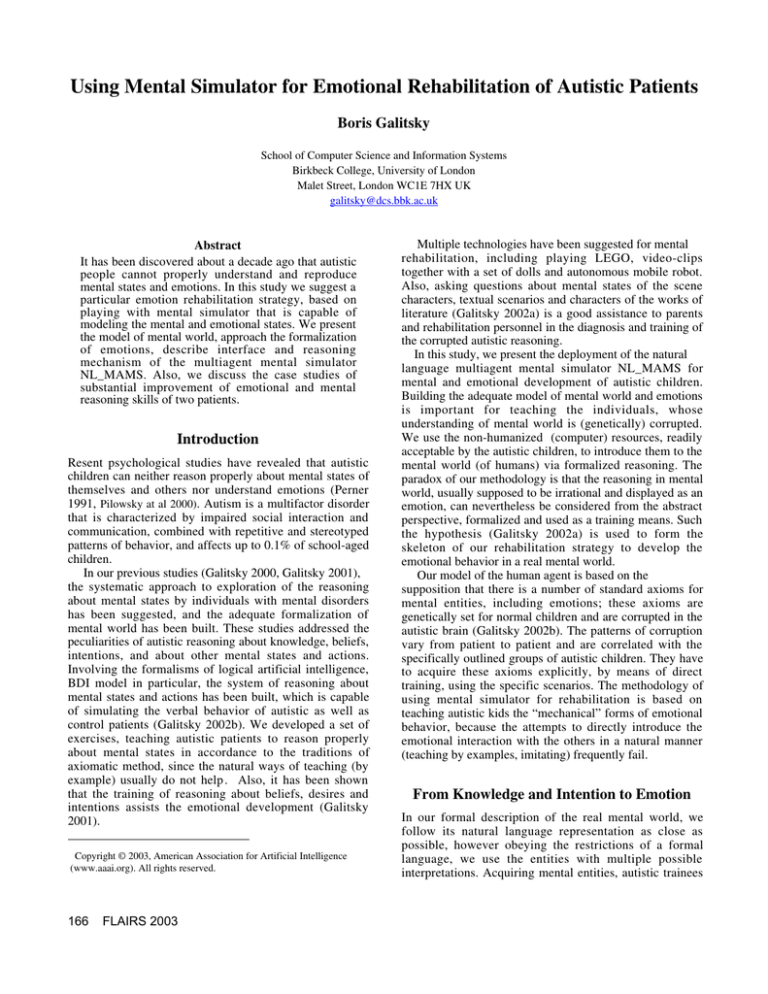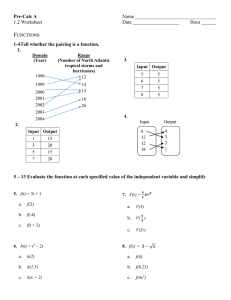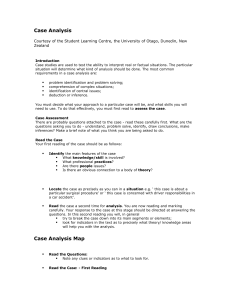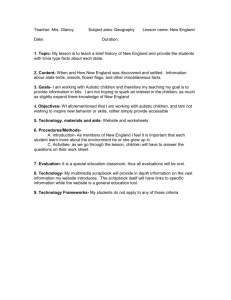
Using Mental Simulator for Emotional Rehabilitation of Autistic Patients
Boris Galitsky
School of Computer Science and Information Systems
Birkbeck College, University of London
Malet Street, London WC1E 7HX UK
galitsky@dcs.bbk.ac.uk
Abstract
It has been discovered about a decade ago that autistic
people cannot properly understand and reproduce
mental states and emotions. In this study we suggest a
particular emotion rehabilitation strategy, based on
playing with mental simulator that is capable of
modeling the mental and emotional states. We present
the model of mental world, approach the formalization
of emotions, describe interface and reasoning
mechanism of the multiagent mental simulator
NL_MAMS. Also, we discuss the case studies of
substantial improvement of emotional and mental
reasoning skills of two patients.
Introduction
Resent psychological studies have revealed that autistic
children can neither reason properly about mental states of
themselves and others nor understand emotions (Perner
1991, Pilowsky at al 2000). Autism is a multifactor disorder
that is characterized by impaired social interaction and
communication, combined with repetitive and stereotyped
patterns of behavior, and affects up to 0.1% of school-aged
children.
In our previous studies (Galitsky 2000, Galitsky 2001),
the systematic approach to exploration of the reasoning
about mental states by individuals with mental disorders
has been suggested, and the adequate formalization of
mental world has been built. These studies addressed the
peculiarities of autistic reasoning about knowledge, beliefs,
intentions, and about other mental states and actions.
Involving the formalisms of logical artificial intelligence,
BDI model in particular, the system of reasoning about
mental states and actions has been built, which is capable
of simulating the verbal behavior of autistic as well as
control patients (Galitsky 2002b). We developed a set of
exercises, teaching autistic patients to reason properly
about mental states in accordance to the traditions of
axiomatic method, since the natural ways of teaching (by
example) usually do not help1. Also, it has been shown
that the training of reasoning about beliefs, desires and
intentions assists the emotional development (Galitsky
2001).
1
Copyright © 2003, American Association for Artificial Intelligence
(www.aaai.org). All rights reserved.
166
FLAIRS 2003
Multiple technologies have been suggested for mental
rehabilitation, including playing LEGO, video-clips
together with a set of dolls and autonomous mobile robot.
Also, asking questions about mental states of the scene
characters, textual scenarios and characters of the works of
literature (Galitsky 2002a) is a good assistance to parents
and rehabilitation personnel in the diagnosis and training of
the corrupted autistic reasoning.
In this study, we present the deployment of the natural
language multiagent mental simulator NL_MAMS for
mental and emotional development of autistic children.
Building the adequate model of mental world and emotions
is important for teaching the individuals, whose
understanding of mental world is (genetically) corrupted.
We use the non-humanized (computer) resources, readily
acceptable by the autistic children, to introduce them to the
mental world (of humans) via formalized reasoning. The
paradox of our methodology is that the reasoning in mental
world, usually supposed to be irrational and displayed as an
emotion, can nevertheless be considered from the abstract
perspective, formalized and used as a training means. Such
the hypothesis (Galitsky 2002a) is used to form the
skeleton of our rehabilitation strategy to develop the
emotional behavior in a real mental world.
Our model of the human agent is based on the
supposition that there is a number of standard axioms for
mental entities, including emotions; these axioms are
genetically set for normal children and are corrupted in the
autistic brain (Galitsky 2002b). The patterns of corruption
vary from patient to patient and are correlated with the
specifically outlined groups of autistic children. They have
to acquire these axioms explicitly, by means of direct
training, using the specific scenarios. The methodology of
using mental simulator for rehabilitation is based on
teaching autistic kids the “mechanical” forms of emotional
behavior, because the attempts to directly introduce the
emotional interaction with the others in a natural manner
(teaching by examples, imitating) frequently fail.
From Knowledge and Intention to Emotion
In our formal description of the real mental world, we
follow its natural language representation as close as
possible, however obeying the restrictions of a formal
language, we use the entities with multiple possible
interpretations. Acquiring mental entities, autistic trainees
are expected to reproduce them in their behavioral patterns
and to reveal them in verbal communication of the others.
Therefore, both natural language and formal language (user
interfaces of a software) representations need to
accompany each mental scenario. Sometimes, autistic
children prefer to operate with the latter: user interface of a
software system seems to be more attractive than reading
or talking in natural language.
Building the simulator of mental world, we need to
extend traditional BDI implementation of reasoning, based
on modal logics that are not well suited for practical
applications, as we are going to show. We believe that
using such logical means as, for example, default logic for
semantic disambiguation, reasoning about action and time
in application to mental world, or constraint satisfaction
machinery for mental states, taken together, do not provide
the solution that is ready for the design of educational
software. Multiagent simulation and case-based system
need to come into play in addition to pure reasoning means
to build the environment, adequate for teaching the laws of
mental world. A mental simulator should be capable of
producing a sequence of consecutive mental states given an
arbitrary initial one.
Adequate description of mental world can be performed
using mental entities and merging all other physical actions
into a constant predicate for an arbitrary physical action
and its resultant physical state (for simplicity). It is well
known that humans can adequately operate with the set of
natural language mental expressions containing not more
then four mutually dependent mental entities. In natural
language, each mental entity has a variety of meanings. At
the same time, a set of meanings which are expressed by a
lexical unit has a lot of common features. Therefore, we
will use the formal representation of mental entities by
metapredicates with multiple interpretations such that we
do not pose explicit constraints on the possible meanings of
a mental entity (metapredicates are the predicates whose
arguments range over arbitrary well-written formulas).
The set of mental metapredicates, formed in accordance
to the respective totality of natural language mental
entities, can be divided into three categories:
• Metapredicates for basic mental states;
• Metapredicates for derived mental states and
actions. They are expressed via basic
metapredicates using mental formulas. For
example, there are families of definitions for
inform, pretend, cheat, reconcile, explain,
convince etc.
• Metapredicates for emotions. Emotions are the
formally independent entities, which are
semantically close to one or another derived ones,
but contain additional meaning.
Indeed, almost any entity for mental state or action can
be defined within these basic mental entities (Galitsky
2000), unless the author of the mental expression wants to
use additional parameters of the agent who is characterized
by that mental state. Usually, this parameter specifies the
mental state of an agent irrespectively on the consecutive
mental state, unless this parameter explicitly points to the
preference in the choice of action. This parameter does not
typically affect the decision-making in terms of the
reaction choice of an agent that is described by such mental
entity.
For example, we can approximate
to be afraid (of
something) by not want (something), when we talk about
an agent that chooses an avoidance behavior. If such the
agent has two choices – to avoid or not to avoid, it does not
matter for his choice of action whether he does not want to
be with another agent or experiences fear with that agent.
Therefore, a derived mental entity forms the class of
equivalence of mental entities (emotions) with respect to
the choice of action (mental or physical, from the fixed
set). The reader can easily construct mental formulas for
forgetting (lack of a belief that follows its presence at some
point in time), dreaming (intention of some physical or
mental state to occur), imagining (believing that something
holds knowing that the belief is wrong), feeling guilty
(intention that some action that has been committed should
not has been done and belief that it depended on the agent’s
physical or mental state), infatuation, fascination, anger,
surprise, embarrassment, shame, anxiety, etc.,
approximating their meanings for particular situations.
We have experimentally verified that one neither has to
enumerate all possible meanings nor approach them as
close as possible to teach applicability and reasonability of
these emotions to an autistic individual. Hence our model
of emotions in the mental world is adequate in terms of
mental rehabilitation, but may be far from optimal for
building agents that impress the audience with intelligent
behavior with emotions (compare with (Scheutz 2001,
Breazeal 1998, Sloman 2000)).
NL_MAMS inputs natural language descriptions of the
initial states of interacting agents and outputs the
deterministic scenarios of the intelligent behavior of
agents, capable of analyzing and predicting the
consequences of mental and physical actions of themselves
and others (Galitsky 2002a,
www.dcs.bbk.ac.uk/~galitsky/ Nl_mams/ ).
NL_MAMS is capable of understanding the messages
from its user and other agents in natural language,
extracting the expressions, which mention explicitly or
assume implicitly mental states and actions. Modeling of
multiagent interaction takes into account possible
ambiguity of messages that is inherent to natural language
dialog. NL_MAMS imitates the multiagent behavior that is
caused by possible misunderstanding of one agent by
another. Under the search of optimal action or reaction, the
set of meanings for received entities is (exhaustively)
analyzed with respect to avoiding the least wanted state
(assuming this state may be achieved as a result of a
particular understanding of a message).
The input of NL_MAMS is an arbitrary (possibly,
inconsistent) set of mental formulas, obtained by the
natural language understanding unit of NL_MAMS. The
output is the set of consecutive mental formulas, reflecting
FLAIRS 2003
167
the states, which are the results of the committed actions
(the behavior), chosen by the agents. The simulator can be
viewed from the game-theoretic perspective if the mutual
beliefs of agents are absent (the trivial case).
To choose the best action, each agent considers each
action he can currently possibly perform. For each such
action, the agent assumes he has committed it and analyzes
the consequences. They include the actions of other agents
and various states, some of which the given agent does not
want to occur. The agents either decides to perform the
action delivering the least unwanted state or action by
another agent, or to do nothing. If there are multiple
possible actions which do not lead, in the agent belief, to
unwanted consequences, this agent either chooses the
preferred action, if there is explicit preference predicate, or
the action, which conjectures use the beliefs concerning the
other agents in the least degree.
The complexity of scenarios NL_MAMS can handle
significantly exceeds that of the textual information on
mental attributes of human and automatic agents,
comprehensible by a human user. The simulator was tested
using a variety of scenarios that were suggested, in
particular, by different authors to illustrate certain
peculiarities of reasoning about mental world inherent to
humans (frame problems, defaults, circumscription, belief
updates, reasoning about knowledge, time and space, etc.)
The system extracted mental entities and reproduced the
described agents’ behavior for more than 20 natural
language scenarios from various sources. As we
discovered, NL_MAMS is capable of adequate processing
more than 70 scenarios, selected so that they accent mental
interaction between their characters. Usually, agents’
behavior that is generated by NL_MAMS is perceived by
its user as a sequence of natural and expected choices. If it
is not the case, NL_MAMS backs its scenario up by
providing the motivation and the protocol of exhaustive
search through the manifold of available actions. A user
may disagree with the selected form of behavior, but at
least understands the motivations.
Note that the particular advantage of NL_MAMS over
the traditional systems of automatic reasoning in mental
states domain is that NL_MAMS merges various forms of
search and a fuzzy match of formulas and deduction
patterns together with conventional mechanisms of
reasoning about mental states. Furthermore, handling
manifold of meanings caused by the necessity to represent
NL input increases system flexibility and makes it closer to
the real world in imitation of human reasoning and human
behavior.
There are three friends: Mike, Nick and Peter.
Nick knows that if Mike gets the toy (asking for it) then Nick’s parents will give him his favorite candies. But Mike and Peter are not sure
that the toy is good… The initial situation is as follows:
Nick’s mental state
Peter’s mental state
Mike’s mental state
Mike(m) wants to get the toy if Peter
Peter(p) wants Mike to get a toy.
Nick(n) wants Mike to get the toy.
informs Mike that the toy is not bad.
Peter does not want Nick to know that Peter
Nick knows that the toy is bad.
Mike wants to get the toy if Peter informs
wants Mike to get a toy.
Nick wants that both Peter and Mike
Mike that the toy is worth getting.
Peter believes that Mike would get the toys if
believe that the toy is not bad.
Mike wants Peter to believe that Mike will
Mike believes it is not bad.
Nick believes that Peter does not know
not get the toy
Peter believes Mike would get a toy if Nick
that the toy is bad.
Mike wants Nick to believe that Mike
informs Mike that the toy is not bad.
Nick knows that initially Mike does not
believes that the toy is not bad.
Peter wants Nick to believe that Mike gets the
know that the toy is bad.
toy if Peter informs Mike that the toy is not bad. Mike wants that Peter informs Nick that
Mike will not want the toy
want(m, get(m, t)):- inform(p,m, not bt);
want(p, get(m,t)).
want(n, get(m,t)).
inform(p,m, get(m, t)).
want(p, not know(n, want(p, get(m,t)) )).
know(n, tb). % tb- toy is bad
want(m, believe(p, not get(m,t))).
believe(p, (get(m,t) :- beleive(m, not tb))).
want(n, believe(p, not tb)).
want(m, believe(s, believe(m, not bt))).
believe(p, get(m,t)):- inform(n,m, not tb).
want(n, believe(m, not tb)).
want(m, inform(p,n, not want(m, get(m,
want(p, believe(n, (get(m,t):- inform(p,m, not
believe(n, not know(p, tb)).
p)))).
tb)) )).
know(n, not know(m, tb)).
Form the statement using combo boxes below
inform
Peter
toy is bad
None
Nick
want
None
Nick
None
None
or input in natural language
Nick wants Peter to inform Nick if the toy is bad.
What will the children do?
Nick asks Peter to tell Mike that the toy is good.
Peter asks Mike to ask Nick if the toy is good.
Mike informs Nick that Mike believes that the toy is not bad.
Nick asks Mike if Mike believes the toy is bad.
Peter informs Mike that the toy is good.
Mike asks that Peter inform Nick that Mike will not get the toy.
Fig.1: User interface of NL_MAMS for learning the mental entities by autistic patients.
168
FLAIRS 2003
User Interface for Autistic Training
In this section, we present the user interface of NL_MAMS
for autistic rehabilitation (Fig.1). A child is encouraged to
understand the initial mental state that includes the initial
emotions of agents. Then this child is suggested to
compose a story of the multiagent behavior and compare it
with what NL_MAMS generates. Doing this, the trainees
actively use a variety of mental entities, including basic,
derived ones and emotions. Each column represent a
mental state of an agent (in natural language on the top
row, in the formal language – on the bottom row). Mental
sates can be modified either in the text area, or using the
row of combo boxes for each predicate name and its
arguments. NL_MAMS builds the resultant scenario, and
the trainee can analyze it and compare with his own vision
of the possible scenario.
Since the majority of autistic children feel very
comfortable with a computer (unlike with other humans),
these children can exhaustively run through combination of
scenarios for the story characters. NL_MAMS suggests the
children to memorize both natural language and formal
language representation of initial mental state and the
scenario. Modifying the parameters of initial mental state,
the trainees demonstrated good skills in revealing the
cause-reason links in multiagent behavior. Being
frequently capable of inductive and abductive reasoning,
the children build the rules for agent’s actions and
emotions rather then performing these actions and
displaying emotions, copying other people as controls do.
We observed that for the mental world deductive, inductive
and abductive kinds of reasoning take autistic patients less
efforts to perform, than analogous reasoning, easily
conducted by controls in the similar environment.
Case Studies and Conclusions
In this paper, we mention two children whose emotion
capabilities are believed to be developed by the suggested
approach in addition to the traditional rehabilitation
methodologies. This pair was chosen from the group of
eight children (from 5 to 12 years old, diagnosed with one
of the autism syndromes) because the training seemed to
better fit their mental age. Alexandra (F) and Leon (M), 10
years old, has attended the rehabilitation center “Sunny
World” on a regular basis, participating in common games
with other children, speech therapy, animal-assisted
therapy and general training for reading, writing and math.
We perform the progress of their emotional capabilities
from the winter of 2001/2002 to the autumn of 2002 (Table
1). Five other patients of “Sunny World” have participated
in the emotional rehabilitation training using NL_MAMS.
We can see that both children dramatically improved
their overall skills of the emotion-related behavior. As we
can judge given the data for two children, each has his/her
own problems that were the direct or implicit targets of the
training. However, certain capabilities have been
developed insignificantly; they may be weakly affected by
the suggested methodology of emotional rehabilitation.
The reader might notice that a lot of additional training has
to be performed so that the mental and emotional
development proceeded towards the normal skills for their
age. As to the other trainees, each of them improved certain
emotional skills and capabilities of reasoning about mental
states to a various degree. Statistical estimates of results of
the NL_MAMS-based treatment are the subjects of the
further studies.
Also, various kinds of emotions are built up at different
speeds for the same patient. As we discovered, training of
each kind of emotion and mental reasoning should be
conducted starting from the earlier ages, because for each
mental task there is an age when this task becomes
adequate to the current patient understanding of the mental
world. Therefore, the training toolkit is assumed to be
suggested starting from the age when a patient is able to
read, till the full (possible) mental recovery in terms of
interaction with other people.
Currently, we are investigating the peculiarities of
autistic reasoning about actions, revealing whether the
children can clearly distinguish fluents from actions and
from states. Also, frequent inability of autistic children to
distinguish the essential facts from the details, which seem
insignificant for a normal individual, is well known. We
explore the correlation of such inability to separate
important / unimportant facts with the intuition for inertia
of physical and mental world.
The phenomenon of computational autism has been
introduced to explore the theoretical and practical issues of
the mental disorders: www.dcs.bbk.ac.uk/~galitsky/AU/
Computational_autism.htm. Current study shows that the
abstract formalism of reasoning about mental states,
intended to model the human behavior by a technical
system, found an emergent application in the simulation of
human agents. The reader is suggested to consult (GrahamRowe 2002) for a popular analysis of how studying logical
constructions assists in the mental development of autistic
patients.
There is a series of multiagent systems where agents are
designed to implement emotions (Breazeal 1998,
Velasques 1998). Also, a number of formalisms have been
developed that handle the notion of emotion quite
adequately (see e.g. Oatley and Jenkins 1996,
Parameswaran 2001, Scheutz 2001). However, the target of
our model for mental world, that includes emotions of
participating agents, is quite different. As we
experimentally discovered, to stimulate the emotional
development of autistic patients, the interface of the
rehabilitation system does not have to display the
emotional behavior explicitly; instead, the canonical
explanation of the strict rules for emotions is required. We
have learned the following from our experimental studies.
When children start better operate with basic entities of
knowing and believing and then proceed to the derived
entities like deceiving and pretending, the further step to
more explicit emotional behavior frequently comes easier
and quite naturally.
FLAIRS 2003
169
Ability to understand
or to perform a mental
action or state
child
Alexandra
Testing date
Good will deception
Unable
2001
Pretending
Unable
Being surprised
On rare occasions
Feeling sorry for another person
Non-systematically
Feeling happiness for another
person
Randomly
Understanding jokes
Unable
Cooperating with others when
performing a collaborative task
Willing to cooperate
without understanding
the common goal
Understanding of intention of
others
Understanding of only
her own intentions
Understanding of knowledge and
beliefs of others
Mostly
misunderstanding
Understanding derived mental
states
No recognition of
pretending
Leon
2002
Deception on a wide
spectrum of topics
Pretending concerning a
subject and concerning
her own mental state
Systematically with
proper timing, playing
with the teacher
Almost always when
appropriate
Frequently when
appropriate
Irregular understanding
of some kinds of jokes
Cooperation on
different matters with
responsiveness and
understanding
intentions of others
Can understand
intentions of others of a
limited complexity
Can understand beliefs
of others in practical
situations; still confused
with own and others’
knowledge
Understands pretending
if it affects her wishes
2001
Deception on limited
number of topics
Pretending on limited
number of topics
Randomly
Never
Sometimes, when
appropriate and
inappropriate
Randomly
Avoiding any
cooperation
2002
Deception on an
arbitrary topic
Pretending on a wider,
but still limited number
of topics
Systematically with
proper timing, playing
with the teacher
Sometimes, when
logically deduced
Frequently when
appropriate, seldom
when inappropriate
Randomly, but with
clear reaction
Cooperation on
demand from the
teacher without
Can understand
Able to mutually
intentions of others,
analyze own and
but ignores them
other’s intentions
Fully understands knowledge and belief of
others up to solving the “muddy children”
problem. Mental age with respect to
understanding knowing is therefore 20 years
old!
Understands pretending if it affects his wishes
Table 1: The progress of mental development for two patients.
References
Breazeal, C. 1998. A motivational System for regulating
Human-Robot Interactions, Proceeding of the Fifteenth
National Conf. On AI (AAAI-98).
Galitsky B.2000. Simulating autistic patients as agents
with corrupted reasoning about mental states AAAI FSS2000 Symposium on Human Simulation, Cape Cod, MA.
Galitsky, B. 2001. Learning the axiomatic reasoning about
mental states assists the emotional development of the
autistic patients. AAAI FSS-2001 Symposium on Emotional
and Intelligent II, Cape Cod, MA.
Galitsky, B. 2002a. On the training of mental reasoning:
searching the works of literature. FLAIRS – 02, Pensacola
Beach, FL.
Galitsky, B. 2002b. Extending the BDI model to
accelerate the mental development of autistic patients.
Second Intl. Conf. on Development & Learning.
Cambridge, MA.
Graham-Rowe, D. (2002) Hope lies in flair for logic.
NewScientist v175 No 2352 July.
170
FLAIRS 2003
Parameswaran, N. 2001. Emotions in Intelligent Agents,
FLAIRS-01, Pensacola Beach, FL, pp.82-86.
Oatley, K. and Jenkins, J. 1996. Understanding emotions.
Oxford: Blackwell.
Perner, J. 1991. Understanding the representational mind.
MIT Press Cambridge MA.
Pilowsky T, Yirmiya N, Arbelle S, Mozes T. 2000.
Theory of mind abilities of children with schizophrenia,
children with autism, and normally developing children.
Schizophr Res. Apr 7;42(2):145-55.
Scheutz, M. 2001. Agents with or without emotions,
FLAIRS-01, Pensacola Beach, FL, pp.89-93.
Sloman, A. 2000. Architecture-based conceptions of
mind. In Proc 11t h International Congress of Logic,
Methodology and Philosophy of science. Dordrecht:
Kluwer, pp. 397.
Velasquez, D. 1998. When Robots Weep: Emotional
Memories and Decision-making, Proceeding of the
Fifteenth National Conf. On AI (AAAI-98).





